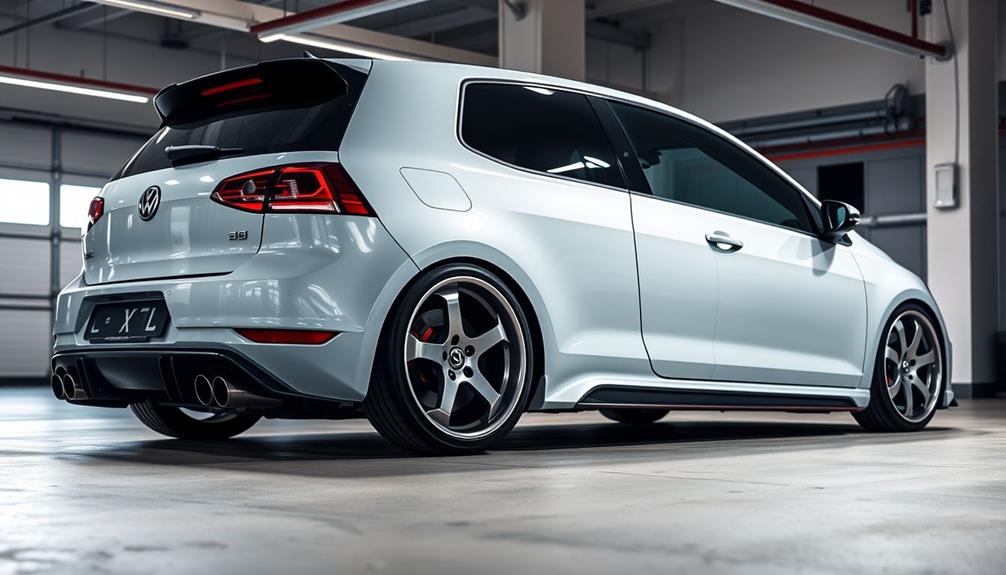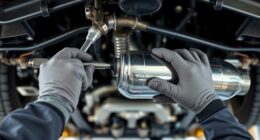Upgrading your MK7 GTI with an improved intercooler will lower intake air temperatures, boost power, and prevent heat soak during spirited driving. An auxiliary radiator helps keep engine coolant temperatures stable, especially under high loads or hot weather. Both mods improve heat management but focus on different areas—intercooler cools charged air, while the radiator handles engine coolant. To maximize performance, combining both upgrades is highly effective; discover how each can benefit your drive.
Key Takeaways
- Intercoolers primarily reduce intake air temperatures, boosting turbocharged performance and preventing heat soak during spirited driving.
- Auxiliary radiators improve engine coolant cooling, stabilizing engine temperatures under high-stress conditions.
- Upgrading the intercooler enhances power output and charge air cooling efficiency, while the radiator maintains consistent engine temps.
- Combining both upgrades offers the best overall thermal management, reducing heat soak and preventing overheating during demanding drives.
- Choice depends on driving style: intercooler upgrades benefit turbo performance, while auxiliary radiators are ideal for sustained high-heat conditions.

If you’re looking to improve your MK7 GTI’s cooling performance, upgrading your cooling system is a smart move. Two popular options are upgrading the intercooler and adding an auxiliary radiator. Both aim to reduce intake air temperatures and prevent heat soak, but they do so in different ways and offer unique benefits.
Focusing on the intercooler, enhancing its efficiency means better cooling of the charged air before it enters your engine. A high-performance intercooler typically features a larger core, improved airflow design, and better heat transfer capabilities. When you upgrade to a larger or more efficient intercooler, you’ll notice lower intake air temperatures, especially during spirited driving or track days. This reduction in charge temperature can translate into increased power and more consistent performance, because cooler air is denser and produces more power when compressed. Improving intercooler efficiency also helps prevent heat soak, which occurs when the intercooler becomes saturated with heat after prolonged use, diminishing its cooling ability. A more effective intercooler maintains lower intake temperatures over time, allowing your engine to sustain higher power levels without overheating. Additionally, selecting an intercooler with proper airflow characteristics can maximize its cooling potential and optimize performance.
Adding an auxiliary radiator is another way to boost your MK7 GTI’s cooling capacity, particularly for the engine coolant system. This small second radiator helps dissipate heat from the engine coolant more effectively, especially during aggressive driving sessions or in hot climates. When you install an auxiliary radiator, it works alongside your stock cooling system, providing additional surface area for heat exchange. This results in more stable coolant temperatures, which directly impacts engine health and performance. Cooler coolant helps prevent overheating, reduces thermal stress on engine components, and can even improve overall efficiency. Plus, with a dedicated auxiliary radiator, you’re less likely to experience heat buildup in the engine bay, especially if you’ve also upgraded other components like your radiator fans or added cooling ducts.
Both modifications serve to improve overall thermal management, but they target different parts of the cooling process. Upgrading the intercooler enhances charge air cooling, which is vital for turbocharged engines like the MK7 GTI’s. An auxiliary radiator, on the other hand, supports the engine’s coolant system, helping it stay within ideal temperature ranges during demanding driving conditions. Many enthusiasts find that combining both upgrades offers the best results—improved intercooler efficiency ensures better power delivery, while an auxiliary radiator keeps the engine cool under stress. Ultimately, your choice depends on your driving style and performance goals, but investing in either can make a noticeable difference in your car’s ability to handle heat and maintain peak performance.
Frequently Asked Questions
How Do Cooling Mods Affect Overall Vehicle Performance?
Cooling mods improve your vehicle’s performance by reducing engine temps, which helps maintain ideal power and efficiency. They can also offer aerodynamic improvements by streamlining airflow and aesthetic enhancements with sleek designs. These upgrades prevent overheating during spirited driving or boosts, ensuring your car runs smoothly and consistently. Ultimately, better cooling means you enjoy more reliable performance, improved handling, and a more visually appealing ride that stands out.
What Are the Long-Term Durability Impacts of Intercooler Upgrades?
Like forging a sword through fire, upgrading your intercooler demands durability. Over time, thermal fatigue may weaken the material, risking cracks or leaks, while corrosion resistance guarantees longevity amidst exposure to moisture and road salts. Properly selected, high-quality intercoolers can withstand these stresses, maintaining performance. But neglecting these factors could lead to costly repairs, turning your passion for speed into a long-term battle against wear and tear.
Are Auxiliary Radiators Compatible With All MK7 GTI Models?
You might wonder if auxiliary radiators fit all MK7 GTI models. Generally, they’re compatible with most, but you’ll want to check aftermarket compatibility and how they affect engine bay aesthetics. Some models may require specific mounting brackets or modifications, so verify your car’s year and setup. Ensuring proper fitment guarantees you get the cooling benefits without compromising the look or performance of your engine bay.
How Do Cooling Mods Influence Fuel Efficiency?
Ever wondered if cooling mods can boost your car’s efficiency? They do, by enhancing thermal management and reducing engine heat. Improved cooling prevents overheating, enabling the best performance and better aerodynamic efficiency. This means your engine runs smoother, consumes less fuel, and minimizes emissions. So, upgrading your cooling system isn’t just about temperature control—it’s about opening more fuel economy and a more efficient drive every time you hit the road.
What Maintenance Is Required After Installing Cooling Upgrades?
After installing cooling upgrades, you need to follow a proper maintenance schedule to keep your cooling system in top shape. Regularly check coolant levels and look for leaks or corrosion. Flush and replace coolant as recommended by your vehicle’s manufacturer. Also, inspect hoses and connections for wear. Staying proactive with maintenance guarantees your cooling system performs efficiently, preventing overheating and extending the lifespan of your engine components.
Conclusion
Ultimately, choosing between an upgraded intercooler or auxiliary radiator is like balancing scales of a mythic tale—each offers its own strength in the quest for cooler, more efficient performance. While the intercooler slays the dragon of intake temps, the auxiliary radiator tames the fire beneath your hood. Your decision shapes your journey, echoing the timeless dance between power and stability—a reminder that even modern machines are part of a grand, ancient saga of endurance and mastery.










